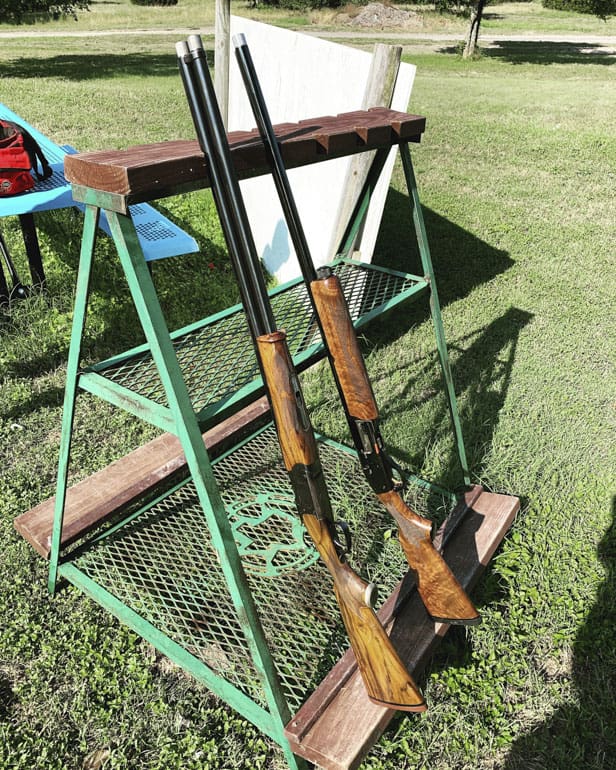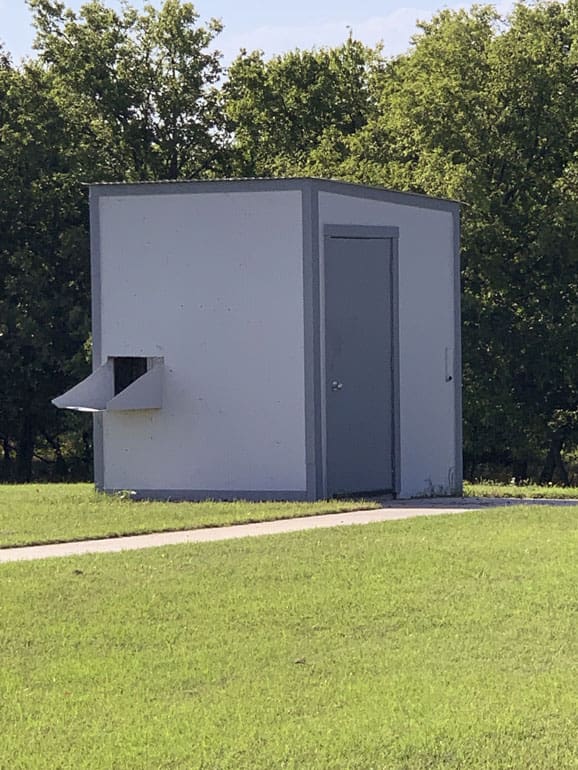
While visiting recently with everyone’s favorite saddle burr, my good friend Male Concubine, he inquired into the current state of my shooting and what I might be working toward right now.
I was honest with him that although I’m happy with the way my pistol skills have come up to par and am about to re-introduce rifle to my practice sessions, I’ve been feeling a little burned out on the whole tactical shooting scene and feel like I need a change, but I’m not sure how.
He suggested I come out with him to a skeet shooting club and get some instruction to see how I liked it. That’s how we ended up at Capital City Clays outside Austin early Saturday morning.

MC brought two shotguns to use. Mine was a Remington 1100 sporting 12 gauge. His was a Remington 3200 special trap 12 gauge. Until that morning I had never as much as held a shotgun, so this was a very “from the ground up” experience.

After getting familiar with the basic operation of loading and mounting the shotgun, MC spent a little time explaining to me the flight paths of the clay birds from the two skeet houses on the field – the left high house and the right low house.
He described which one gets pulled first depending on which side of the field you’re standing on. He also took me through a basic orientation of the eight different shooting positions that are marked on the skeet field.

Although I was oriented to the numbering of all of the positions, all of my instruction and shooting practice happened at position 1 in front of the high house, and position 7, in front of the low house. We used two flights of clays for my lesson, each consisting of 25 birds.

Since I already have shooting experience, MC focused on orienting me to the most important points of basic skeet shooting:
1. Body position
2. Cheek weld
3. Movement of the gun and when to pull the trigger.
The basic instruction for body position was this: left foot forward in a moderate athletic stance with weight shifted into the left (front) foot, not in a deep lunge but enough to place the weight clearly forward, with the left toes pointing toward the break point of the shot. The index finger of the support hand was pointed down the barrel and the cheek weld had to be solid and unmoving.
It took me a while to get the hang of moving the gun and watching the bird while never interrupting the cheek weld. The natural tendency is to lift one’s head to watch the trajectory of the clay, which breaks your cheek weld and essentially renders the shot useless.
After some practice, I had that figured out, the secret was to treat my entire upper body as a unit and not let any of my parts come unglued from a good starting position on the shotgun. The movement really comes from the action of the ribs and waist. Pointing the left toes toward the break point mean that you’re in the most relaxed position at the moment of the shot.
I had to get used to the process of starting at the break point and then moving the gun back to the hold point before calling “pull.” It also took a while to get used to how to think about and orient myself toward incoming and outgoing birds depending on which side I was standing on.
I asked MC to shoot a series of birds while I watched. What I observed was how controlled and smooth his movement with the shotgun was…much less movement than it felt like when you’re behind the gun.
When I got back into the shooter position, I decided to concentrate on keeping my cheek weld solid and moving the barrel smoothly. From that point forward, I broke all but a couple of birds. The key was staying focused on those key points, keeping both eyes open, and letting my mind be more relaxed than it usually is when I’m practicing.
MC explained how skeet is different than tactical work in the sense that the minute the bird is in the right place, you make the shot. It isn’t the kind of micro-precision shooting that one sometimes does with tactical rifle and pistol.
He also explained why the best break points are the best because of the speed and trajectory of the bird. I started to see how skeet and trap shooting actually enhance your tactical skills by getting you out of a rigid shooting position, introducing a moving target, and making you comfortable with tracking and approximating a moving center of mass. Not to mention training for this skill from eight different shooting positions.
It was clear to me after the session that the instruction that MC has given me at carbine matches about how to approach swinging targets is drawn from his extensive clays shooting and bird hunting experience.
Afterward, we re-hydrated while I learned the difference between trap, skeet, and sporting clays shooting. MC taught me a little about the history of the sport and the evolution from glass ball targets to the non-toxic 4” clay disks we use today.
There is a whole world to explore in terms of clay shooting, from recreational to competitive. I’m encouraged by the fact that with precise and good instruction, I was able to find a fair amount of skill in just one session as a complete beginner who was unfamiliar with both shotguns and this form of shooting sport.
Looks like I may be volunteering to push buttons on a trap machine in future. And since my polymer pistols haven’t seen a day of use since I transitioned to a CZ SP01, a trade-in toward a skeet gun may be in my future. It’s possible!





Never did cotton up to skeet…Trap, yes(Beretta 686 Whitewing O/U), shot league for many yrs, Sporting Clays, yes(Benelli Supersport) when I moved to my current location…
Worked in Trap houses for many yrs…
Show me on this doll how the operator touched you.
Dude that was so funny I spit coffee all over my laptop! 🙂 Thank you!
You didn’t spit any coffee and you probably didn’t even lol.
Another story about his non straight relationship with an operator!
We don’t need to push buttons on the trap machines here. They’re voice activated, which is nice if you’re the only one on the field. Only the skeet and 5-stand need a “pusher”.
“one ringy dingy, two ringy dingy…”
First, what is an operator? Second, go for real lessons.
FelixD
He’s won many international skeet competitions and pre-qual’ed for the Olympic team at one point, so I’m not too worried about the quality of the instruction I’m getting.
http://oafnation.com/category/hitter-feed/
Operators operating operationally
and in the Area of Operation!
It’s who you get when you press “0” on your phone
Nifty article, I liked this, the best part, “Afterward, we re-hydrated while I learned the difference between trap, skeet, and sporting clays shooting, then MC focused on the skeet houses as I assaulted these positions kicking the doors in, tossing in flash bangs, entering and filling the targets with lead”.
Male concubine — a man regarded as a sex object by a woman. Lucky guy.
Never could handle the taste of clay pigeons.
At least you don’t have to deal with all those little pin feathers!
They’re no good fried. You have to slow cook them for like three days.
Rachel Ray has a recipe for ice cream. Grind the clay into a powder and add it to the mix.
Knew it was an Elaine article from the title.
Good lord I can’t believe TTAG is still posting this crap.
Yeah, unfortunately I clicked on the article before I noticed who the author is. She’s even trolling the comments now, claiming her make-believe friend is an internationally successful skeet shooter.
At least she has an imagination?
Well now, that’s the most interesting thing in the article. A “former special forces” guy who qualified for the Olympic in skeet? That narrows things down quite a bit.
Well I might have to do a little research, should be fairly easy to un-mask this operator now.
An operator and a male concubine! This woman is something else. What a waste of time.
A fine article.
I shot trap and sporting clays for years. They are great games and really do teach you to shoot moving targets with rifles and handguns. They are also lots and lots of fun. Especially sporting clays. Every course is different.
There was absolutely no information in this entire piece.
“How an elite SEAL team 6 Operative taught me to shoot better”
(He said you need to shoot the clays, and I did, and we had fun.)
…………….WTF
For spending a day or more with someone who claims to be an elite operator and “almost Olympic shooter” you got NO information on how to improve shooting skills other than learning another sport.
Tip Elaine, when you talk about how you are learning from a pro, people expect to hear things like “he informed me that you need a smooth consistent trigger pull using the apex of the first knuckle until the moment the sear breaks and quickly reset the trigger while sweeping to the next target……”
Not, “He showed me good cheek weld and how to move around.”
B,
He taught me appropriately for a first time lesson with someone who had never held a shotgun before. I was breaking the birds. For me that’s a fine and dandy result for one lesson lasting about an hour, I’ve got no complaints at all!
I can see you must be from the generation that takes pictures of what they’re eating every day like everyone cares.
“He showed me how to shoot clays. I shot some and missed some. It was fun.”
Still better than the other BS she wrote about the operator operating in operations.
Try 5 Stand. Best of all types of clay shooting.
Well, I’ve never shot clays with a shotgun, and don’t know anything about it. But I want to learn. So, I read the article. Now I feel I know even less than I knew before I read it. Geeze, what a bunch of crap.j